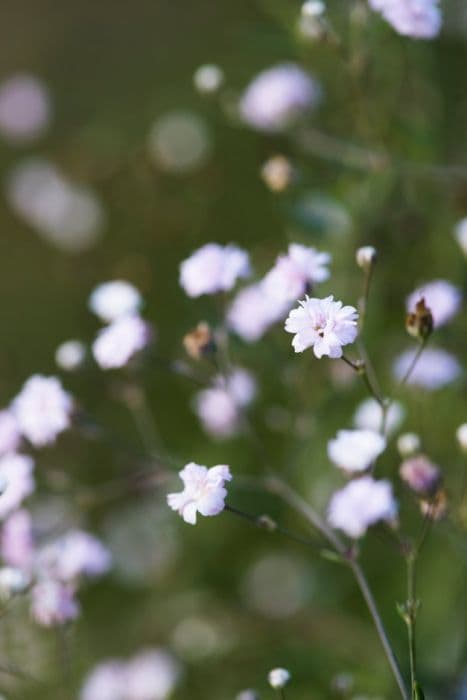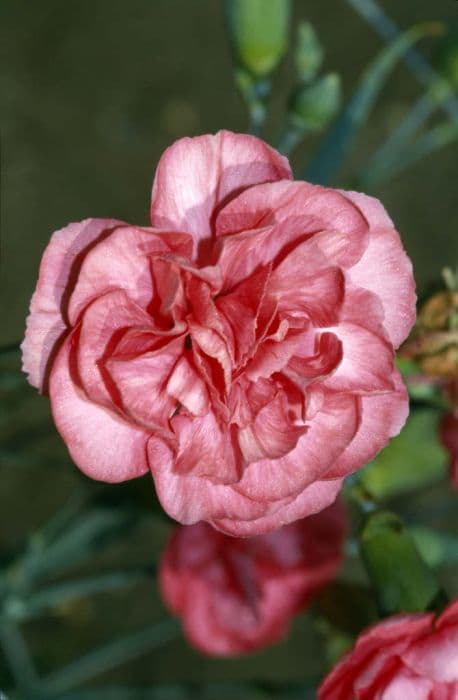Carnation Dianthus caryophyllus 'Coquette' (pf)

ABOUT
The 'Coquette' variety of carnations is a beautifully ornamental plant known for its striking flowers and pleasant fragrance. The blooms exhibit a heady mix of colors, typically featuring a blend of pink and white or a vivid deep pink hue, sometimes with lighter pink or white edges. Each flower is composed of numerous fringed petals that are soft and velvety to the touch, creating a ruffled appearance that is characteristic of carnations. The blossoms are carried on top of sturdy stems, which are surrounded by narrow, lance-shaped leaves. These leaves are typically a greyish-green to blue-green color, providing a lovely contrast to the vibrant blooms. The plant as a whole gives off a sweet and spicy scent that adds to its allure, making it a popular choice for cut flower arrangements, borders, and garden displays.
About this plant
 Names
NamesFamily
Caryophyllaceae
Synonyms
Carnation, Clove Pink, Divine Flower, Gillyflower
Common names
Dianthus caryophyllus.
 Toxicity
ToxicityTo humans
The plant commonly known as Carnation typically does not contain toxins that are harmful to humans. It is generally considered non-toxic, and accidental ingestion of reasonable quantities is unlikely to cause any serious harm or significant symptoms. However, some people may experience a mild stomach upset or skin irritation if they have allergies or sensitivities.
To pets
Carnations are considered to be mildly toxic to pets, such as cats and dogs. If a pet ingests part of a Carnation, it may exhibit symptoms like gastrointestinal upset, including vomiting, diarrhea, or a decrease in appetite. Although the toxicity is generally considered low, it is still advisable to keep an eye on the pet and consult with a veterinarian if any adverse symptoms develop after ingestion.
 Characteristics
CharacteristicsLife cycle
Perennials
Foliage type
Evergreen
Color of leaves
Blue-green
Flower color
Pink
Height
1-2 feet (30-60 cm)
Spread
1 foot (30 cm)
Plant type
Herb
Hardiness zones
6
Native area
Mediterranean
Benefits
 General Benefits
General Benefits- Aesthetic Appeal: Dianthus caryophyllus 'Coquette', commonly known as Carnation, offers bright and vibrant flowers that enhance the beauty of gardens and landscapes.
- Fragrance: Carnations are known for their sweet, spicy fragrance that can be enjoyed in the garden or as cut flowers in bouquets.
- Cut Flowers: Carnations have a long vase life, making them popular choices for floral arrangements and bouquets.
- Cultural Significance: Carnations have symbolic meanings in various cultures and are often used in ceremonial events such as weddings and funerals.
- Easy to Grow: These plants are relatively easy to care for, making them suitable for gardeners of all skill levels.
- Attracts Pollinators: Carnations can attract bees and butterflies, contributing to the health of the garden ecosystem.
- Seasonal Variability: With a variety of bloom times depending on the cultivar, Carnations can provide color for extended periods.
- Edible Flowers: Some Carnation petals are edible and can be used for culinary decoration or as ingredients in certain dishes.
- Versatility: Carnations can be grown in beds, borders, and containers, offering flexibility for different gardening spaces and styles.
 Medical Properties
Medical Properties- Antioxidant properties: Carnation (Dianthus caryophyllus) extracts have been reported to contain compounds with antioxidant activity, which may help in protecting cells from oxidative stress.
- Anti-inflammatory effects: Some studies suggest that extracts of Dianthus caryophyllus possess anti-inflammatory properties, potentially useful in reducing inflammation.
- Antimicrobial activity: The essential oil and extracts from carnations may exhibit antimicrobial properties against certain bacteria and fungi.
- Diuretic action: In traditional medicine, carnations have been used for their diuretic effect, which can help in the management of fluid retention.
- Anxiolytic-like effects: There is some evidence to suggest that the fragrance of Dianthus caryophyllus can have a calming effect and reduce anxiety in aromatherapy uses.
 Air-purifying Qualities
Air-purifying QualitiesThis plant is not specifically known for air purifying qualities.
 Other Uses
Other Uses- Culinary Garnish: Carnation petals are edible and can be used as a colorful, spicy addition to salads, desserts, and drinks.
- Art and Crafts: The vibrant flowers of carnations can be pressed and used for making bookmarks, greeting cards, and other paper crafts.
- Perfumery: Carnation's rich fragrance is often used as inspiration for perfumes and scented oils.
- Dye: The flowers can provide natural dyes for fabrics, with different colors yielding different dye shades.
- Traditional Ceremonies: Carnations are used in various cultural ceremonies across the world, including weddings and funerals for their symbolic meanings.
- Education and Research: Carnations are model organisms in genetics and biology for studying flower evolution and development.
- Potpourri: Dried carnation petals can be incorporated into potpourri mixes for a long-lasting fragrance in your home.
- Floral Arrangements: Carnations are popular flowers for floral arrangements not only due to their beauty, but also their longevity after cutting.
- Ice Cubes: Petals of carnations can be frozen in ice cubes for an elegant touch in beverages for special occasions.
- Scented Sachets: Dried carnation flowers can be used to create scented sachets to freshen up drawers and closets.
Interesting Facts
 Feng Shui
Feng ShuiThe Carnation is not used in Feng Shui practice.
 Zodiac Sign Compitability
Zodiac Sign CompitabilityThe Carnation is not used in astrology practice.
 Plant Symbolism
Plant Symbolism- Love: Carnations often symbolize love and affection, with different shades representing different aspects of love. The 'Coquette' cultivar, with its playful name and vibrant colors, may convey a flirtatious, whimsical kind of love.
- Distinction: The name "dianthus" comes from the Greek words for divine ("dios") and flower ("anthos"), conveying a sense of nobility and excellence. 'Coquette' carnations might represent pride or individuality, perhaps with a hint of playful superiority.
- Fascination: Historically, giving someone a carnation could mean that the giver is fascinated by the recipient. The 'Coquette' variety, suggestive of teasing and enticing behavior, could emphasize this meaning even further.
- Devotion: Carnations are often associated with deep, lasting affection and commitment, making them suitable for expressing love that endures over time.
- Women's love: In some cultures, carnations are particularly associated with women's love. The 'Coquette' may carry connotations of feminine charm or allure.
 Water
WaterCarnations require watering to keep the soil moist but not waterlogged. Typically, you should water your Carnation 'Coquette' once every week with approximately one inch of water, but you'll need to adjust this depending on the weather conditions. During hot, dry spells, watering may need to be increased to twice a week, while in cooler, wetter conditions, it may need to be reduced. Use a watering can or hose to water at the base of the plant, avoiding wetting the foliage, which can encourage disease. Always check the top inch of soil before watering; if it feels dry, it’s time to water.
 Light
LightCarnations thrive best in full sun conditions, where they can receive at least six hours of direct sunlight per day. The ideal spot for a Carnation 'Coquette' would be in a garden bed or container that has clear exposure to the sun for the majority of the day. However, in very hot climates, they would benefit from some afternoon shade to avoid scorching.
 Temperature
TemperatureCarnations prefer cooler temperatures and can generally tolerate temperatures as low as 20 degrees Fahrenheit and as high as 80 degrees Fahrenheit. The ideal temperature range for growing Carnation 'Coquette' is between 60 and 70 degrees Fahrenheit. Avoid planting in areas that experience extreme heat or freezing conditions to ensure the health and longevity of the plant.
 Pruning
PruningPrune Carnations to promote bushier growth, remove spent flowers, and maintain plant health. Deadheading, or removing dead flowers, encourages the Carnation 'Coquette' to produce more blooms and prevents seed formation. Cut back the foliage by one-third in late summer to rejuvenate the plant and encourage a flush of fall blooms. The best time for heavier pruning is in early spring, just before new growth begins.
 Cleaning
CleaningAs needed
 Soil
SoilCarnations thrive in well-draining, neutral to slightly alkaline soil with a pH of 6.7 to 6.9. Mix equal parts of garden soil, sand, and peat for best results.
 Repotting
RepottingCarnations should typically be repotted every 1-2 years to refresh the soil and accommodate root growth.
 Humidity & Misting
Humidity & MistingCarnations prefer moderate humidity levels around 40-50% and do well in typical household conditions.
 Suitable locations
Suitable locationsIndoor
Place carnations near a sunny window and ensure good air circulation.
Outdoor
Plant in full sun with well-draining soil and space for air flow.
Hardiness zone
6-9 USDA
 Life cycle
Life cycleThe life of a Carnation (Dianthus caryophyllus 'Coquette') begins with seed germination, which occurs in moist, well-drained soil under warm conditions. The seedlings emerge and establish a root system before developing true leaves and forming a sturdy stem. As the plant matures, it produces a rosette of foliage at the base and elongates to form flowering stems. The Carnation blooms, displaying its colorful and fragrant flowers, which can be harvested for cut flowers or left on the plant for ornamental purposes. After pollination, the flowers develop into seed capsules containing numerous small seeds, completing the reproductive cycle. The plant may continue to grow and produce flowers for several years if properly cared for, or it may die back after setting seed, depending on growing conditions and cultivar traits.
 Propogation
PropogationPropogation time
Spring-early summer
The Carnation (Dianthus caryophyllus 'Coquette') is commonly propagated through cuttings, which is the most popular method due to its efficiency and high success rate. The ideal time for taking cuttings is late spring to early summer when the plant is actively growing. To propagate by cuttings, a gardener should select healthy, non-flowering shoots and cut a 4 to 6-inch (10 to 15 cm) length, ensuring at least a couple of nodes are included on each cutting. The lower leaves are removed, and the base of the cutting is often dipped in a rooting hormone to encourage root development. Then, the cutting is inserted into a well-draining soil mix or a propagating medium. The cutting should be kept moist and placed in a warm area with indirect light until roots develop, which typically takes a few weeks. Once the cuttings have rooted, they can be transplanted into individual pots and grown on until they are ready to be planted out into the garden.









